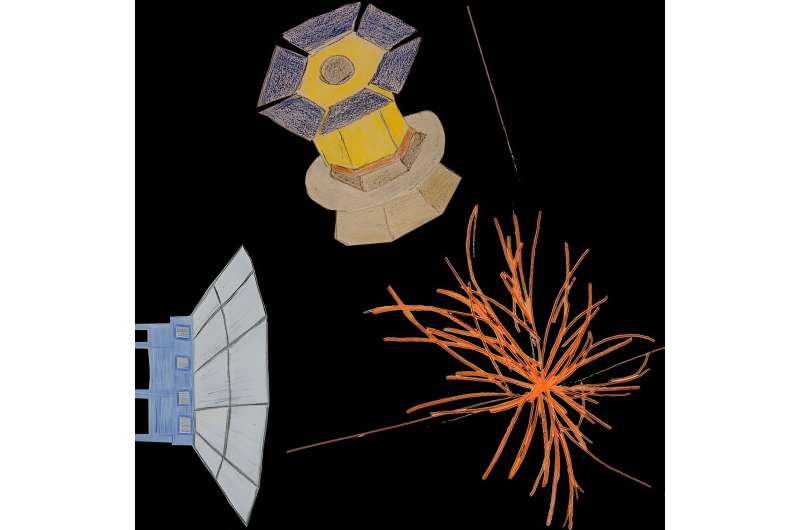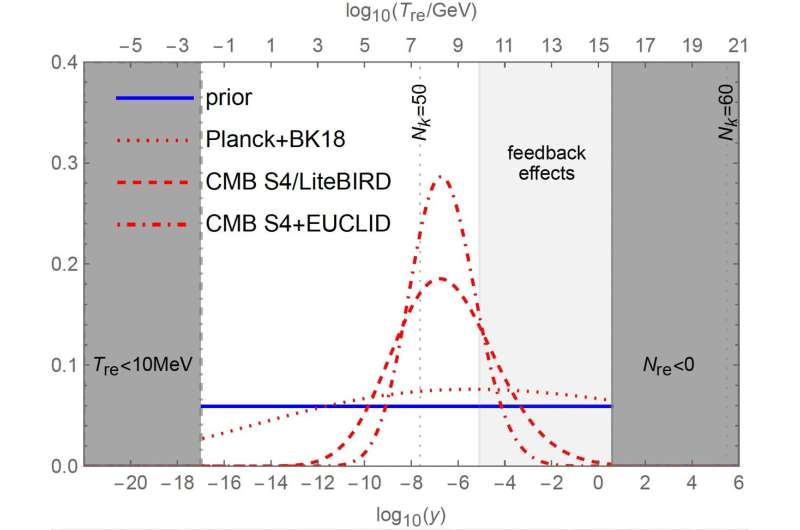
August 2, 2024 by Ingrid Fadelli , Phys.org
Collected at: https://phys.org/news/2024-08-cosmic-microwave-background-probe-inflation.html
Various large-scale astrophysical research projects are set to take place over the next decade, several of which are so-called cosmic microwave background (CMB) experiments. These are large-scale scientific efforts aimed at detecting and studying CMB radiation, which is essentially thermal radiation originating from the early universe.
Researchers at Université Catholique de Louvain in Belgium recently showed that upcoming CMB observations with the Japanese LiteBIRD satellite or the primarily U.S.-funded CMB Stage 4 (CMB-S4) observatories could, by detecting primordial gravitational waves, measure the coupling of the so-called inflaton field to other particles for the first time, with further improvement possible if data from optical surveys or next-generation radio telescopes are added.
Their paper, published in Physical Review Letters, suggests that this measurement could help to explore the connection between cosmic inflation and particle physics.
“One of the most astonishing aspects about the Standard Model of particle physics is that it does not only describe all elementary particles found on Earth in terms of a few symmetries and a handful of numbers, but these laws also seem to be universal enough to hold in distant regions of the cosmos and in processes that happened in the first moments after the Big Bang,” Marco Drewes and Lei Ming, the two authors of the paper, told Phys.org.
“It is a natural question to ask how far we can go back in history with theories of particle physics—and what we can learn from the early universe about New Physics beyond the Standard Model.”
The research by Drewes and Ming draws from their fascination with the connection between particle physics and cosmology. Their recent paper builds on previous studies by Drewes that first began in 2015, which laid the groundwork for Ming’s PhD project.
At the time of the study, Lei Ming was a visiting PhD student at UCLouvain and was part of Drewes’ research group. Since then, he has graduated and started working at SYSU Guangzhou.
“It is widely believed that the overall homogeneity of the observable universe is the result of a phase of accelerated cosmic expansion dubbed ‘cosmic inflation’ about 14 billion years ago,” Drewes and Ming said. “However, it is not known how the mechanism that drove this acceleration is connected to a fundamental theory of nature, and especially to the Standard Model of particle physics. An important key could be provided by the imprint of ‘cosmic reheating’ in the CMB.”
Cosmic reheating is the process through which the early universe was filled with a hot plasma, following its cooling by the inflationary expansion. This process ultimately established the initial conditions for the “hot Big Bang,” which resulted in the formation of the universe as we know it.
Some previous studies had already explored the possibility of constraining the universe’s initial temperature using CMB data. Yet the study by Drewes and Ming takes this one step further, investigating the extent to which this data could contain insight about the connection between CMB and particle physics.

Reheating is driven by the interactions between the field responsible for driving cosmic inflation (i.e., the inflaton) and other particles, and hence is sensitive to the fundamental coupling constant that governs the strength of this interaction (the inflaton coupling). An analog to this coupling rooted in high-school physics would, for example, be the elementary charge that governs the interaction strength between the electric field and charged particles.
“We showed that experiments like CMB-S4 or LiteBIRD can for the first time measure the coupling,” Drewes and Ming said. “This is a microphysical parameter that has not only shaped the evolution of our cosmos by setting the initial temperature of the primordial plasma during the Big Bang, but can also tell us something about the connection between models of cosmic inflation and theories of particle physics. Our work therefore adds a new aspect to the physics cases of these experiments.”
To model the process of reheating, researchers need to use a combination of techniques rooted in particle physics, particularly quantum field theory, and statistical mechanics. In their previous works, Drewes and Ming achieved this using an approach known as the Schwinger-Keldysh formalism.
“In earlier works, we did this using the so-called Schwinger-Keldysh formalism, a method to describe nonequilibrium quantum processes in a dense medium that was originally developed in condensed matter physics and later generalized to particle physics to identify the conditions under which the inflaton coupling can in principle be constrained with CMB data,” Drewes and Ming explained.
As part of their recent study, the researchers used these results to determine whether the next-generation of CMB experiments could actually, in practice, perform this measurement. To do this, they used a technique rooted in Bayesian statistics, exploiting the sensitivity of future detectors to primordial gravitational waves.
“The sensitivity in our current study is primarily driven by the CMB-S4 or LiteBIRD sensitivity to primordial gravitational waves from inflation,” Drewes and Ming added. “We now plan to investigate how much more information can be obtained when including other observables, such as non-Gaussianities in the cosmological perturbations or the so-called running of the spectral index.”
Overall, the results of the analyses carried out by this team of researchers demonstrate the potential of future CMB experiments for probing the connection between cosmic inflation and particle physics.
Drewes and Ming hope that their study will encourage the National Science Foundation (NSF) and other funding organizations to support CMB research, including activities at the South Pole that have been placed on hold in May 2024 and would pave the way for the CMB-S4 experiment.
More information: Marco Drewes et al, Connecting Cosmic Inflation to Particle Physics with LiteBIRD, CMB-S4, EUCLID, and SKA, Physical Review Letters (2024). DOI: 10.1103/PhysRevLett.133.031001
Journal information: Physical Review Letters

Leave a Reply